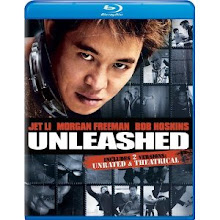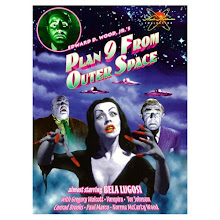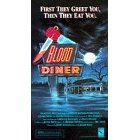Monday, October 20, 2008
To This Blog's Documentary Filmmakers
by Jason Pyles
I have an unofficial recommendation for the documentary filmmakers that contribute to this blog: You should watch “My Kid Could Paint That” (2007), if you haven’t already seen it.
You’ve no doubt heard about it. “My Kid Could Paint That” is about a 4-year-old girl named Marla who begins to receive international recognition and acclaim in the art world for her contemporary, abstract oil paintings … but seeds of doubt are soon sewn as to the little artist’s authenticity and abilities.
I suggest checking out this movie because it qualifies as an unusual film in the documentary genre. Amir Bar-Lev, the filmmaker, shows up in the film a lot more than just as a “camera-placer.” He can be heard speaking to his subjects, speaking directly to us — giving his opinions. He can also be seen in the film, and consequently, he appears in the cast credits.
Perhaps that’s not too unusual, considering that documentaries have come to be defined with vast leeway, though there are many purists that would vehemently disagree.
But what makes this film interesting — especially to Andrew and Josh, the co-directors of the untitled CleanFlicks documentary — is how a “situation” luckily unfolds while the camera is running. Indeed, the best documentaries capture this kind of serendipity.
In “This Divided State” (2005), Steven Greenstreet told my Cinema Studies class that he decided to start filming Michael Moore’s visit to Utah Valley State College and a much bigger controversy erupted than he expected. Greenstreet said Kay Anderson made the film a real story. (I know some of you also worked on that film, part of this background is for those who haven’t heard about it.)
Then, with the CleanFlicks documentary, it appeared that the battle between Hollywood and CleanFlicks was the whole story, but ironically, when Daniel Thompson (a prominent champion of edited films) was said to be using his edited movies store, “Flix Club,” as a front for “a pornography studio” — and he and his business partner, Isaac Lifferth, were convicted this past summer (with varying sentences) of having sexual relations with two 14-year-old girls, well, another story burst open before the filmmakers’ cameras.
[Full Disclosure Note: Interestingly, for those who don’t know, I was the in-house movie critic for Flix Club, the very store, and I wrote movie reviews about the edited movies. ( Here is the address: http://www.flixclub.blogspot.com/. Oh, and the name of the last film I reviewed there is somewhat humorous.) I didn’t know about those other "dealings," bien sur, but I still — and always will — consider Daniel to be a friend of mine. Everybody makes mistakes; some are just worse than others.]
Anyway, much like Andrew and Josh, filmmaker Amir Bar-Lev grew to know and like the family that he had been shooting for so long, and when the controversy starts to unravel, he lets us know that he’s torn over it. So what is so noteworthy about “My Kid Could Paint That” is how the filmmaker must begrudgingly ride the train and let it take him where it’s going, even though he’s reluctant about what his camera will discover.
But also much like Andrew and Josh, Bar-Lev bravely proceeds forward, as a good documentarist should. Props to Andrew, Josh and Amir.
Subscribe to:
Post Comments (Atom)






























































2 comments:
Jason,
Thanks for the recommendation. I have indeed seen My Kid Could Paint That and it has been an interesting influence on me as I've thought about the Cleanflix documentary. I have actually been trying to get Andrew to watch it for some time as I feel that the filmmaker was grappling with many of the same issues with his film as we are with ours.
Stylistically, the film is very different and not a good film for us to look at in terms of visuals or content, but I do wonder if taking a closer look at the structure could serve us well. As I was telling Andrew last week, the film is really split into three distinct sections that are almost three different films. First, you have the documentary the filmmakers set out to make, an examination of modern art through the lens of this young girl. Second, there is the twist that is thrust upon the filmmakers, which I will not spoil for those that haven't seen the film. And third, you have this fascinating meditation on non-fiction filmmaking in general where the filmmakers turn the focus on themselves and try to figure out the most responsible way to tell this story.
Maybe all documentarians and reality filmmakers go through this, but it was especially poignant to me because at the time I saw it because I was going through my own personal examination of the ethical ways in which to tell a shocking and salacious true story. I definitely think anyone making non-fiction films should watch My Kid Could Paint That. Not because it's an amazing film, really, but because it deals with all of the questions and concerns that any thoughtful person is going to have when shaping a story using the lives of real people. So, thanks again for the recommendation. You were right on in thinking that it might apply to us.
Also, I am sorry that I haven't participated in this blog for some time. Andrew and I have been swamped with the Cleanflix documentary (getting a cut in to Sundance and off to our investors) and I also found a financial need to work as a Production Designer on another director's narrative feature film. I'm especially sad that I missed the conversation on There Will Be Blood. I think that this is a great group of thoughtful film watchers and although the way that I view films differs greatly from many of the group, I am always interested in hearing the ideas and experiences of others. I'll try to participate more in the future.
Joshua,
Yes, tell Andrew I said he should take your recommendation and check out "My Kid Could Paint That." Also, the two of you have no doubt seen "Hoop Dreams" (1994), but just in case you haven't, Roger Ebert considers it one of the greatest documentary films ever made. And he's right.
When I wrote this initial post the other day, I felt compelled to visit my Flix Club blog and put an explanation in the right-hand column. I'm not sure why, at this point. Nobody asked me (except you two), but I thought if any viewers of your film venture onto my blog, I wanted them to be able to read how I was associated with Flix Club.
Anyway, when I was visiting the site, I saw where you asked if I had my articles in digital form. No, unfortunately, I don't think I do. However, there might be one more place I can check. I'll get back to you on that.
As for your comment regarding "My Kid Could Paint That," yes, it's that third portion of the film where the filmmaker turns and focuses on himself (especially the driving scene) that I haven't seen before in other docs. I guess one could argue that Morgan Spurlock or Michael Moore always seem to implicate themselves into their films, but this is entirely different, because we get the feeling that the filmmaker initially didn't plan on being in his own film. Indeed, it begins with the camera as a silent, invisible (to us) onlooker. And I like how eventually, he ventures out IN FRONT of the camera, as the interviewer.
I'm glad to hear you're plugging away at the CleanFlicks documentary. Remember, I want to purchase one of the first DVD copies from you guys. I, too, am fascinated with your story.
Lastly, don't worry about being busy. Everybody's busy. Write whenever you can. I'm here to hold down the fort and keep it rolling. I'll keep trying to provoke you all. And if you'd like to recommend a movie pick, let me know your selection and I'll stick it into the rotation. Oh, and you can write a post for "There Will Be Blood," or any film for that matter, any time you want. It doesn't have to be "the film of the week."
Thanks for writing.
Jason
Post a Comment